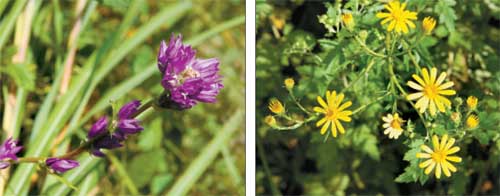Mid-DMZ teems with wildlife

About 450 species of flora and fauna were found in the middle section of the demilitarized zone, according to the Environment Ministry yesterday. Two plants whose scientific names are campanula glomerata (left) and senecio argunensis (right) were among rare species the research team found in the civilian-limited area. [YONHAP]
the mid-section of the civilian-restricted
demilitarized zone between North
and South Korea has revealed a rich
landscape of flora and fauna.
Scientists from the National Institute
of Environmental Research have
identified some 450 species of animals
and plants around large areas of wetland
in Cheorwon County, Gangwon,
which occupies this middle section.
It is the second ecological survey to
be carried out along the demilitarized
zone. Last November researchers from
the NIER conducted a similar study in
the western part of the demilitarized
zone, around Paju and Yeoncheon in
Gyeonggi.
Last month’s survey was led by
Kim Kwi-gun, a professor of ecology
at Seoul National University. It was
conducted in 11 different locations
within Cheorwon County by 18 experts
from 12 different fields of study
over five days last month.
A total of 334 species of plants and
116 species of animals, including elks
and soft-finned cyprinodont fish, were
found. In addition, researchers discovered
snakes, wildcats, goshawks and
sparrow hawks, all of which the Environment
Ministry has designated as
endangered species.
The number of species found in
last year’s survey in the western part of
the demilitarized zone was 348.
“The central zone of the DMZ connects
the plains in the west to mountainous
area in the east,” said Kim
Myeong-jin, a scholar at NIER. “The
surveyed region has a high ecological
value since it is a very good habitat for
various plants and animals.”
The land that Cheorwon County
sits on is composed of volcanic rock
dating back to the Mesozoic age, according
to Kim. “There are even some
spots that were bombed so heavily in
the Korean War that the landscape
changed completely,” Kim said.
The researcher also found wildcats
and cyprinodonts inhabiting Hajinhyun
valley, plus antelopes, golden
eagles and trout. However, Kim said
preventive measures are needed to
stop ecosystem-threatening species
such as bullfrogs from spreading since
a number of those species were found
during the survey.
The Environment Ministry is planning
to research the eastern parts of the
demilitarized zone by the end of 2011.
“We are planning to turn the DMZ into
a global peace park and tourist attraction
as well as making it a Unescodesignated
biosphere reserve,” said
Kim.
In line with the Environment Ministry’s
project, the Ministry of Culture,
Sports and Tourism plans to divide the
DMZ into 10 areas, each with a distinct
tourist attractions and will jointly constitute
the Peace Life Zone.
By Kang Chan-soo, Lee Min-yong [smartpower@joongang.co.kr]










with the Korea JoongAng Daily
To write comments, please log in to one of the accounts.
Standards Board Policy (0/250자)